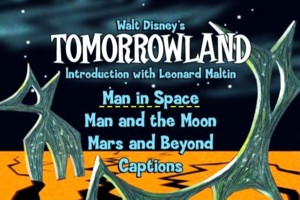
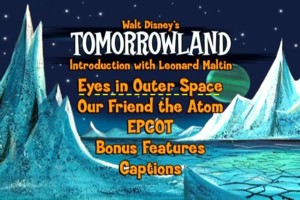
| The Disney Company released several DVDs in the early 2000s, called "Walt Disney Treasures." One of these DVDS is "Tomorrowland", and features the four "Tomorrowland" episodes broadcast on Disneyland: space documentaries, first aired in 1955 and 1957. Also in this set is a theatrical featurette, and an unreleased, promotional film called Epcot.
Extra features include an interview with Ray Bradbury, an interview with Marty Sklar, and various photo galleries. |
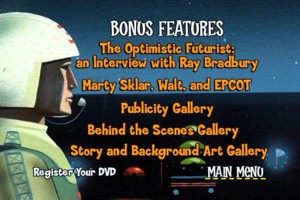 |
| Date |
Episode |
Notes |
| March 9, 1955 |
"Man in Space" |
2nd to last episode of first season (21 episodes total) |
| December 28, 1955 |
"Man and the Moon" |
14th episode of second season |
| January 23, 1957 |
"Our Friend the Atom" |
14th episode of third season |
| December 4, 1957 |
"Mars and Beyond" |
12th episode of fourth season |
| April 1, 1962 |
"Spy in the Sky" |
First television broadcast of 1959 movie featurette, "Eyes in Outer Space" |
| N/A |
"Epcot" |
Promotional featurette for EPCOT (aka "Waltopia"), a futuristic city which Walt Disney wanted to build at Disneyworld. Completed filming two months before he died on December 15, 1966. Its purpose was to be shown to politicians and industry in an effort to generate funds for the city. |
|
In the early 1950s, Walt Disney was a successful movie producer with 12 feature films (11 animated, one live action) under his belt, not to mention hundreds of cartoon shorts from those featuring the Alice character to those starring Mickey Mouse, and more.
Disney had a dream to build an amusement park. There were plenty of such parks, but he wanted his to be fun for the whole family - not just the kids.
In order to get the financing to build that park, he made a deal with the new American Broadcasting Company (ABC). They would put up the money to build the park and own half of it for five years, and they would also air a weekly television program called Disneyland, which would feature advertisements for the park, as well as Disney films and other programs.
Disneyland: The TV Series
The season began on October 27, 1954, with the broadcast of "The Disneyland Story." Walt Disney himself was the host, and would continue to host the show until his death some 12 years later.
Disneyland was an anthology series which would feature shows divided into four areas - the four areas into which the theme park Disneyland (which opened only a year after construction began, on July 17, 1955!) would also be divided: Adventureland, Fantasyland, Frontierland, and Tomorrowland.
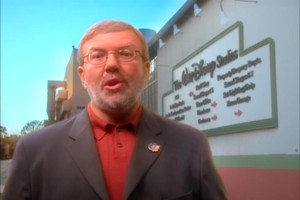
Leonard Maltin |
Film historian Leonard Maltin introduces each of the features on these two discs, and interviews Ray Bradbury and Marty Sklar. Indeed, Maltin hosts all of the Disney Treasures CDs.
What interest can 50-year-old documentaries on space exploration hold for people living in the 21st century? Plenty!
First off, they're very fun to watch. Althought they were originally aired in black-and-white, they were filmed in color, in anticipation of the day when color TV sets would be sold.
|
They'd be a ton of fun even if they weren't in color, but since they are, even today's jaded kids will want to sit and watch.
The best "rocket scientists" of the day helped Disney with these documentaries - Wernher von Braun, Willy Ley and Heinz Haber. (For more information about these rocket scientists, visit Lost Rocket Summer.)
However, while there's lots of footage of these three men talking about the plans of the future, there's plenty of "visual aids" to illustrate what they're saying about the visualized rocket ships and space stations and trips to the Moon and Mars.
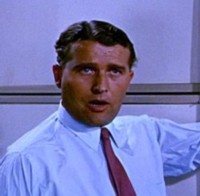 |
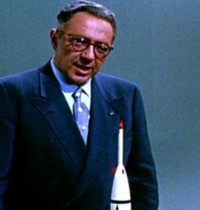 |
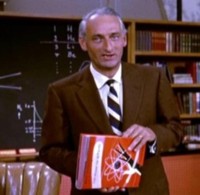 |
Wernher Von Braun |
Willy Ley |
Heinz Haber |
In addition, there's plenty of fun animation, illustrating history of scientific advancement, and a trip to Mars, and live action enactments of a trip around the Moon, and the successful diversion of a hurricane from hitting the coast of North Carolina.
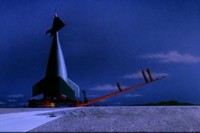 |
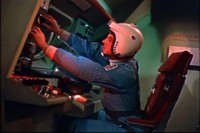 |
In "Man in Space," a rocket is moved out onto the launcing pad.
In "Man and the Moon," a live action enactment of a possible trip to the moon. |
| In "Mars and Beyond," an egghead's secretary abducted by Martians (she rescues herself).
In "Eyes in the Sky," an enactment of a weather control station diverting a hurricane from hitting the North Carolina coast. |
 |
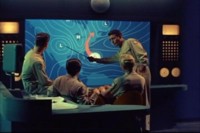 |
The first three episodes, "Man in Space," "Man and the Moon," and "Mars and Beyond" are rather bittersweet, for they show the plans that were being made by NASA in 1955 and 1957... then Russia beat the United States into space with the launch of Sputnik on October 4, 1957.
American pride was hurt, and all plans for an orderly exploration and exploitation of space went by the wayside, as the plan instead became to put a man on the moon as soon as possible.
We highly recommend this disc set - you will enjoy it and it will educate you at the same time.
The general flow of each episode:
1) Man in Space March 9, 1955 -
Narrated by Dick Tufeld (Voice of Lost In Space Robot)
Later released as a featurette accompanying the movie Davy Jones and the River Pirates in 1956
Introduced by Walt Disney
The episode begins with animation tracing the rocket and various space travel ideas from their earliest beginnings.
China. Battle of -
Sir Isaac Newton - for every action forcce, there is always an equal but opposte reaction force
Steam considered - Charles Golightly - aerial stam horse
Gunpowder - Jules Verne - From the Earth to the Moon - via a cannon
George Melies in 1902 created La Voyage dans la Lune
Herman Gonsfinn - pull, not push
Robert Goddard
Herman Oberth
Frau im Mond
every type of vehicle adapted to rocket power - cars, planes, railroads, boats, snowmobiles
German rocket V2
75 V2s brought to White Sands
Viking, Corporal, Arobee, others
Willy Ley explains how rockets work
WAC Corporal rocket - achieves height of 250 miles
Smedicine
Hienz Haber - man's physical reactions to being in space:
pressure, weightlessness - falling constantly
smoke, breath doesn't move
radiation - cosmic rays
meteorites
outside movement
eating - radio frequency short wave cooking
sleeping
Von Braun - pressure suits
Lt Col John p Stapp - rocket sled
future rocket ships - training
"If we were to start today," a practical passenger rocket within 10 years
step-by-step research and developmemt program
Dick Tufeld narrates how the 4 stage rocket would work
2) Man and the Moon -
Will be rerun 4 years later under the title, "Tomorrow the Moon" (1959)
It will be many years before mankind
Ward Kimble talks, as other people go into room
Legends and facts, foibles, superstitions of man in the moon
Narrator -
Primeval man thinks of legends of the Moon
What various cultures thought the moon was:
Plutarch - demons inhabited moon
Lucian of Samosata 160 AD
Dark Ages
1609 - Galileo built a telescope
Kepler - Somnium
Francis Godwin - the Man in the Moon
Cyrano de Bergerac
1835 - an American newspaper reports John Herschel discovers life on the moon - turns out to be faked, a hoax by the paper
From earth tothe moon - Jules Verne
Great literature references the moon (Shakespeare)
Odd beliefs and superstitions
-Green cheese
-resting place for all articles lost on earth
-new moon - hair grows back to fast, etc.
nursery rhymes
inspiration for love songs
Kimble then speaks - astronomers tell us billions of stars and other worlds
Origin of the solar system
description - New moon, full moon, etc.
Moons influence the earth - tides
Prominent dark areas - plains surrounded by craters
Experts agree the other side (shadow side) looks much like the other side.
A plan for a trip around the Moon - Wernher Bon Bruan
First - building a space station
Then - going around the moon
A scouting trip - no landing attempted.
1st half of trip takes 5 days. - 5 days to return
Let us imagine that the problems have been solved:
The first voyage around the moon: "An on the spot account of the first expedition around the mon) - A live action enactment documentary.
The crew still have gravity...then they don't. Eating, reading, with things floating in space
Emergency Two!
Meteor hit, #2 nitric acid tank!
Get in the bottle suit!
The bottle suit gets out to repair a leak.
Leak fixed. Trip continues.
Even now, construction is going forward on an atomic powered rocket ship that will challenge the limitless depths of space and solve the mystery of the Red Planet Mars.
3) Mars and Beyond (December 4, 1957)
Garko the Robot introduces Walt Disney
Man from the beginning - in his cave, to looking at stars and wondering what they were
The earth was an island floating in water,
stars used to plant and harvest crops
Narrated by Paul Frees
Man begins to build cities, becomes an asttronomer, seeks a moore logical explanation
Egyptians, Greeks, over a thousand years
stupidity, surperstition and sorcery
Renaissance - Nicolas Copernicus - earth not the center of the universe
no mention of religious objections...
Galileo
People speculate about life on other planets
(no dates of when each of the stories referenced are given)
HG Wells
An illustrated version of a 1950s pulp story - a secretary is kidnapped by aliens and has to rescue herself while her boss, a big brain, puffs on his pipe and thinks.
Today, as modern science seeks to understand the miracle of creation
Let us follow the story of our own earth from its misty beginnings... (Big Bang onward)
"Nature has created in man..."
Temperature range
extremes of our solar system
Discussion about Mars through history
1840: map of mars
Lowell, etc. Mars a dying planet
1954 - a new green area seen - opened up to irrigation?
W shaped cloud formed every day during 6 months
EC Sleifer foremost authority on Mars
Fantasies of what is on Mars.
Werner Von Braun and Heinz Haber. We don't hear their dialogue, Paul Frees narrates the scenes of them talking to each other.
13 months to get to Mars
An animated version of the men getting ready to go to Mars- 6 ships!
Dramatic music!
13 months and 6 days - voyage to Mars completed. Ships orbit the planet.
These questions will be answered by our space pioneers of the future
4) Our Friend, The Atom
Starts with ancient Greece, and then marches forward...
Heinz Haber is host and guide
"In God's good time..."
Then Disney comes into it, briefly, to comment on 20,000 Leagues Under the Sea
"We don't pretend to be scientists. We're storytellers."
Haber then introduces the Fisherman and the Genie
Haberman talks about the "genie" of atomic power
How the vessel was discovered, .... finally harnessed to grant us three witches
Ancinet Greece - 400 BC.
John Dalton revives the atom theory.
1811 - Amadeo Avogadro - combined atoms or molecules
billions of billions of water molecules to make a single drop of water
Look at heat with an atomic eye - ice cube to steam
the Mechanical Age
steam for ships and trains, electricity
Henri Becquerel - developed plate - fogged
Marie and Pierre Curie - radium
Albert Einstein - E = mc2
atom not indestructible
Lord Ernest Rutherford - atom mostly empty space - nucleus of the atom
electrically charged particles - protons, neutrons
Table of elements and their atoms
moustraps illustrate it all
1938 - Berlin, Germany - "the vessel opens"
Hans und Fritz Strassmam - atomic fission
"We are like the fisherman. When he beheld the frightful form of the genie, he too wished that he had never found the vessel.
But our fable had a happy ending. The fisherman had h is means of making a friend of making a friend of his enemy."
An atomic blast is more than a threat.
To make this energy useful, it must be slowed down
Blocks of uranium serve as atomic fuel - control rods that absorb neutrons are inserted. Heat is picked up by a liquid, wh ich is run through a boiler which produces steam for power. The reactor makes ordinary material radioactive.
The decision is ours
For the growth of our civilization, our first wish will be power
atomic subs, atomic airplanes, atomic rockets
clean, silent, plentiful
2nd wish - food and health
magic tools for health
radioactive food for plant and animals - ever growing population
atomic medicine
cobalt bomb - fighting cancer
3rd and last wish - atomic genie remain ever our friend
It lies in our own hands to make wise use of the atomic genie
5)Eyes in Outer Space
Made its debut in the movies in June, 1959 as a half-hour featurette
first shown on TV in 1962 episode, :Spy in the Sky:
narrated by Paul Frees
jazzy music
Sputnik October 1957
A rocketship shown on a launch pad. It launches.
Man-made satellites circle the earth.
Give us knowledge for future exploration, and the weather
Scenes of hurricane destruction
Weather - beauty, our daily bread, all living things
Cartoon about the weather
history of predicting weather -superstition and science
Animation of a drip of water and what happens to it - jazzy - from drop to cloud
? (rain actually comes from dust in the air.... no dust, no raindrop)
Constantly repeating cycle of weather - back to film - clouds, water, sun
It all starts with the sun.
The earth - envelope of air,
sun heat is it unevenly, which causes wind
eddies, air pressure
Weathermen
Can past weather predict the future - animal migrations, man migration, ancient tree rings
Info from rockets
Satellites - in space
What's in a satellite and how info is tranmitted to earth
Next is a futuristic story of weather prediction and control
-prediction of a storm in the Atlantic, moving a hurricane away from the east coast of North Carolina
Success...the hurricane has been defeated
Weather control will enrich and safeguard our daily lives
Our eyes in outer space
Epcot
October, 1966 - he died 2 months later
The entire film now has never been shown to the general public.
"Welcome to our DisneyWorld project."
Bring you up to dte for some of the plans for Disneyworld (Disneyland is in California)
Sketches and plans are simply a starting point...everything in this room may change time and tie again.
"We know what are goals are, we know what we hope to accomplsish."
Share some of our ideas for Disneyworld
Experimental Prototype Community of Tomorrow - EPCOT
"We don't presume to know all the answers, in fact we're counting on ..."
Next we see preliminary sketches and layouts.
Ends abruptly:
"We're ready to go right now!"
|

